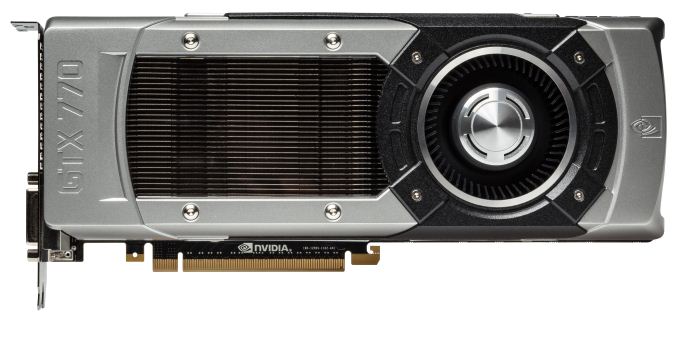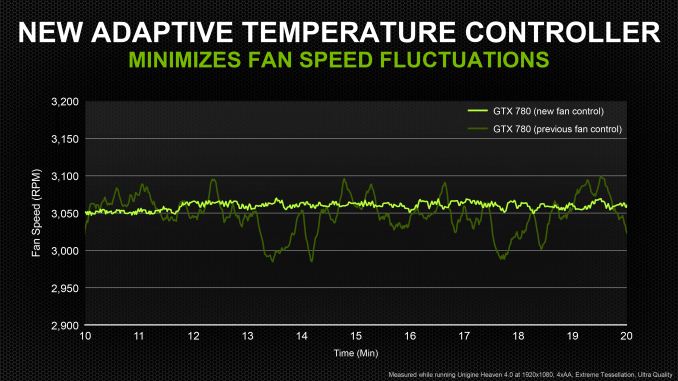NVIDIA GeForce GTX 770 Review: The $400 Fight
by Ryan Smith on May 30, 2013 9:00 AM ESTMeet The GeForce GTX 770
It’s unfortunate that none of NVIDIA’s North American partners will be selling cards based on NVIDIA’s reference design, since NVIDIA is once again using GTX Titan as their template for their design, making for a very high quality card. At the same time it’s unfortunate the reference design will not be available because it means that not everything we have to say about GTX 770 will be applicable to retail cards. We’re essentially reviewing a card with a unique cooler you can’t buy, which has been something of a recurring problem for us with these virtual launches.
In lieu of the reference design, NVIDIA’s partners will be going semi-custom right from the start. A lot of what we’re going to see are various 2 and 3 fan open air coolers, however at least a couple of partners will also be selling blowers, albeit plastic in place of the Titan-derived metal cooler. Still, blowers may be a bit hard to come by with GTX 670, which is something of an odd outcome given how prevalent blowers have been at this performance tier in the past.
In any case, we have a few different semi-custom GTX 770 cards that just arrived in-house (all of the overclocked variety) which we’ll be looking at next week. In the meantime let’s dive in to NVIDIA’s reference GTX 770.
Whereas GTX 780 was truly a Titan Mini, GTX 770 has a few more accommodations to account for the differences between the products, but the end product is still remarkably Titan-like. In short, GTX 770 is still a 10.5” long card composed of a cast aluminum housing, a nickel-tipped heatsink, an aluminum baseplate, and a vapor chamber providing heat transfer between the GPU and the heatsink. The end result is that NVIDIA maintains Titan’s excellent cooling performance while also maintaining Titan’s solid feel and eye-catching design.
The story is much the same on the PCB and component selection. The PCB itself is Titan’s PCB retrofitted for use with GK104 instead of GK110, which amounts to a handful of differences. Besides a new memory layout suitable for a 256bit bus operating at 7GHz, the other big change here is that NVIDIA has scaled down the power circuitry slightly, from a 6+2 phase design for their GK110 cards to a 5+1 phase design for GTX 770, in reflection of GTX 770’s lower 230W TDP.
On that note, for those of you looking for clean pictures of the PCB and GPU, unfortunately you will be out of luck as NVIDIA used the same silk-screened Shin-Etsu thermal compound as they did for GTX Titan. This compound is great for transferring heat and a great thing for GTX 770 buyers, but its composition and application means that we can’t take apart these cards without irrevocably damaging their cooling capabilities, and at the same time NVIDIA didn’t take pictures of their own.
Anyhow, with all of the similarities between GTX 770 and GTX 780/Titan, we are otherwise looking at a card that could be mistaken for Titan if not for the “GTX 770” stamped into the card’s shroud. This means that the I/O options are also identical, with a set of 8pin + 6pin power sockets providing the necessary extra power, a pair of SLI connectors allowing for up to 3-way SLI, and the NVIDIA standard display output configuration of 2x DL-DVI, 1x HDMI, 1x DisplayPort 1.2.
Like GTX 780, we expect to see some interesting designs come out of NVIDIA’s partners. The Titan cooler sets an extremely high bar here given the fact that it was designed for a higher 250W TDP, meaning it’s slightly overpowered for GTX 770. Meanwhile NVIDIA’s Greenlight approval program means that their partners semi-custom and custom designs need to maintain roughly the same level of quality, hence the common use of open-air coolers.
| GeForce Clockspeed Bins | ||||
| Clockspeed | GTX 770 | GTX 680 | ||
| 1149MHz | 1.212v | N/A | ||
| 1136MHz | 1.2v | N/A | ||
| 1123MHz | 1.187v | N/A | ||
| 1110MHz | 1.162v | 1.175v | ||
| 1097MHz | 1.15v | 1.15v | ||
| 1084MHz | 1.137v | 1.137v | ||
| 1071MHz | 1.125v | 1.125v | ||
| 1058MHz | 1.112v | 1.125v | ||
| 1045MHz | 1.1v | 1.112v | ||
Moving on to overclocking, as this is a GPU Boost 2.0 part, overclocking will also operate in the same way it did on GTX 780, and yes, this includes overvolting. GTX 770’s maximum power target is 106% (244W), and a very mild overvoltage of +0.012v is available, unlocking one higher boost bin. This also means that GTX 770 follows the usual TDP and temperature throttling conditions, with a standard temperature throttle of 80C. In practice (at least on our reference card) GTX 770 typically reaches its highest clockspeeds before it reaches the TDP or temperature throttles, so these are mostly of use in concert with overvolting and the use of offset clocks.
Finally, GTX 770 also includes the incremental fan speed improvements first introduced last week with GTX 780. So like GTX 780, GTX 770’s default fan controller programming is biased to react more slowly to temperature changes in order to minimize sudden shifts in fan speed.


















117 Comments
View All Comments
djboxbaba - Thursday, May 30, 2013 - link
I'd say thats a good choice for the 1440p monitor. As far as the actual card, I agree with you that your decision should be between those 2 cards. Just as performance of the 7970GHz has increased due to driver updates, I think we can expect some performance increase from the 770 over time as well. Not sure why that was not mentioned at all in the article. If i were in your situation it would probably come down to the bundled games that come with the AMD card, do you want those games?yasamoka - Thursday, May 30, 2013 - link
No, we cannot expect performance increases from the 770 over time due to driver updates. The 770 is GK104, same architecture as the GTX680. It's just a higher-clocked 680. 680 drivers have been rolling since its release in March, it's been 14 months.The regular game-specific performance improvements will be there for both cards, for games that are coming, but we can't expect the 770 to improve in performance due to drivers as it is already a 14-month mature product (refresh), driver-wise.
EJS1980 - Thursday, May 30, 2013 - link
That makes no sense. If the 7970 has been benefiting greatly from each driver update, and its almost 6 months older than GK104, why can the 7970 improve but the 770 can't?Galidou - Saturday, June 1, 2013 - link
Wow that's a real lack of information to come up with an answer like this. 7970 was a COMPLETE remake of what had been done before. Totally justifiable that drivers improved performance like the gtx 600 series that was new. The 770 is TOTALLY a 680, physically, it's simply a GK 104 die pushed to the extreme, almost nothing new on the driver side from 680 to 770. Not that they can't improve anything but most of the job is done on the driver side of things.Stuka87 - Thursday, May 30, 2013 - link
Did you mean to say 7970Ghz? The 7950 is already at $300, has been for some time.joel4565 - Thursday, May 30, 2013 - link
Yeah I did mean 7970Ghz. Sorry for confusion.EJS1980 - Thursday, May 30, 2013 - link
I'd say forget the Dell, and go with an Overlord Tempest OC. It's the same price & panel as you'd get from Dell, except it can be overclocked to 120hz. They're a California based company, and their sales/IT departments are awesome. If you're not interested in overclocking, they sell a 60hz model for about $400. You should seriously check them out.cbrownx88 - Friday, May 31, 2013 - link
I went to their page and everything is sold out... :(Hrel - Thursday, May 30, 2013 - link
Pretty happy to see Nvidia FINALLY realize the potential of this architexture. Gives me hope for the next generation; combined with a process node drop we should see pretty impressive performance. This refresh will keep the market feeling fresh until then. I just hope they're a lot more aggressive with pricing. I know you say in the article that you were surprised by this price; but really it's still too high. It's not absurd or anything, and assuming the price drops 50+ bucks by fall it's in line with GPU market trends. But I'd like to see some price pressure FROM Nvidia, instead of AMD always being the one to kick off a price war.trajan2448 - Thursday, May 30, 2013 - link
Most of the reviews I've seen have had the 770 beating the 7970gE pretty well. It seems this site really bends over to make AMD look as good as possible, even though the 7970 uses more power and is generally slower and more expensive.